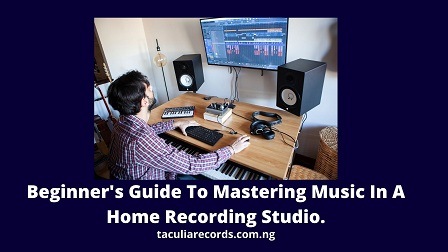Now that you have your own small home recording studio running, you need to focus more on producing high-quality tracks, and in this article, I am going to give you the beginner’s guide to mastering music in a home recording studio.
What is music mastering?
Music mastering is the process whereby finishing touches are put on recorded tracks to enhance the general sound, create consistency across the album, and prepare the song for the public’s consumption.
Music mastering might be considered the final stage in music-making.
The main purpose of mastering an album is to ensure there is cohesiveness among the tracks.
You don’t want track 1 to sound high, and when track 2 comes in the listener will have to add more volume in order to be able to hear the music; because it is sounding too low.
Therefore, one of the things done during music mastering is ensuring all the volumes are on the same level.
Below are some of the processes involved in mastering music in a home recording studio.
Audio Restoration.
Audio restoration is the process of removing unwanted sounds like hiss, impulse or background noise, crackle, etc from a recorded piece or piece of music.
This can be done with a software DAW on a computer, or a hardware machine.
Restoring audio differs from one DAW to another, so you must check how to do so in the particular workstation you are using.
Stereo Widening.
Stereo widening is an art of music mastering where the perceived width of a mix or individual instruments is increased.
As the name implies, it often makes the song sound wide and fat.
There are so many ways to achieve this and some are using plugins like phasing, delays, and reverbs; or panning the instruments to different positions of the stereo field.
You can do this by inserting FX on individual instruments, or through a master bus.
Equalization.
Equalization is a fundamental process in music mastering in a home recording studio.
And there are so many things that need to be done on this single stage alone; which time will not allow us to do here.
However, you can discover them in this article: 12 tips to effectively equalize during mastering.
Compression.
Compression during music mastering is also a very fundamental process, and if you don’t get it right you can ruin your overall mastering process.
And for that reason we took time to discuss it in the article which you can read; 10 tips for using compression during mastering.
Loudness.
For music loudness, it all depends on how loud you decide to make it sound.
But it could be a great idea to play more professional music to hear their level of loudness. And start from there.
The only thing you want to avoid is audio clipping; which is the distortion that occurs as a result of overdriving an amplifier to deliver an output voltage or current that is beyond its maximum capability.
Sample rate conversion and bit reduction.
The sample rate is the rate at which your final sound is going to playback in all musicals.
You can apply a dither plug-in on the master and save your song at 16-bit / 44.1 kHz, but 24-bit, 96-kHz audio is also accepted and considered as “high resolution.”
Sequencing and Spacing.
The space you create between the songs when you are mastering music in a home recording studio is important to the listening experience, and for that reason, you need to be artistic when you do so.
The way you will achieve this will vary depending on the digital audio workstation (DAW) you are using.




